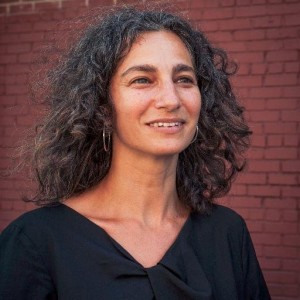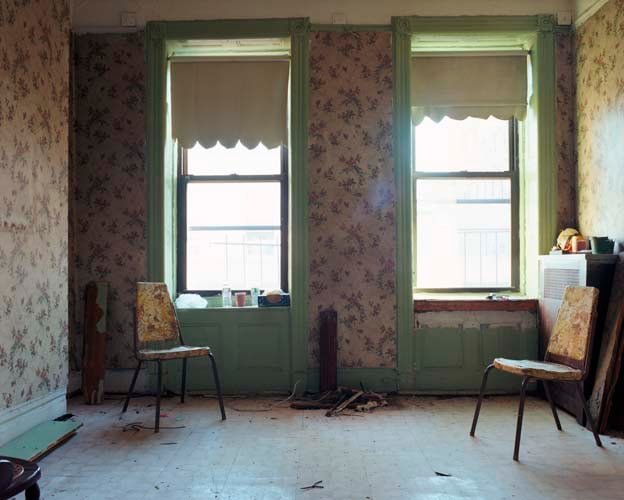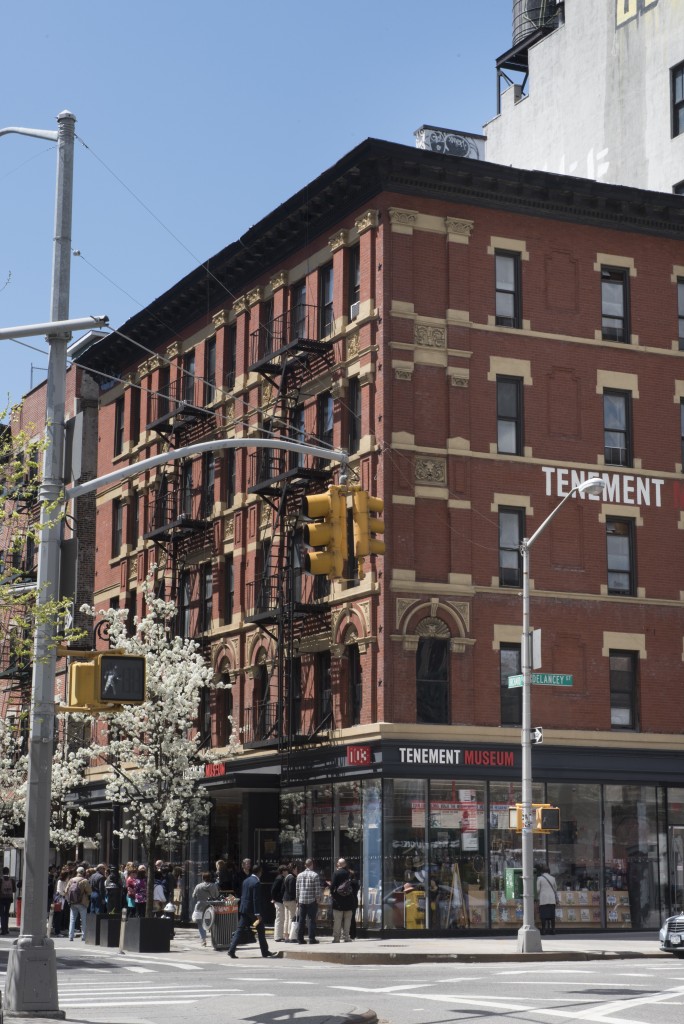Blog Archive
Q & A With Annie Polland
Annie Polland, PhD, is the Vice President of Programs and Education at the Lower East Side Tenement Museum, and has dedicated countless hours bringing to the public a modern view of American immigration history. With the development of the new exhibition at 103 Orchard Street, Annie hopes to bridge the gap between what we think of when we imagine the historical Lower East Side — an image often trapped at the turn of the century — and the diverse yet trendy neighborhood it is today.
The mid-20th century is not only a vital era for many nationalities coming to America at this time, but it also greatly altered the landscape of American culture forever. Annie took the time to answer some questions about how a museum of this nature comes into being, and what the Tenement Museum hopes to accomplish with the new exhibit.

Annie Polland, Vice President of Programs and Education at the Lower East Side Tenement Museum. Photo by Benjamin Hoste.
What is the new project at 103 Orchard St?
AP: This exhibit will focus on three families, all of whom lived in 103 Orchard Street in the post World War II era. We’ll tell the story of Kalman and Regina Epstein, refugees who survived the Holocaust and came to the Lower East Side in 1947 to start a new family. This story relies on the memory of their eldest daughter, Bella Epstein Seligsohn, who was born here on the Lower East Side and moved with her family to 103 Orchard in 1955. The next story is that of Jose Velez, who came with his mother, Ramonita Rivera, and his brother in the mid-1950s and moved into 103 Orchard in 1962. Ramonita, like many Puerto Rican women, came for the employment opportunities in the garment industry, and wanted a better life for her children. We’ll also tell the story of the Wongs, who came to New York in 1965, and moved into 103 Orchard in 1968. Mrs. Wong worked in the burgeoning Chinatown garment industry, and this will be a central part of their story.
How did this project initially get started?
AP: In many ways, the impetus for the new exhibit came from the museum founders’ original philosophy and methodology. From the very beginning they understood the importance of not focusing all exhibits on one particular time period, say, for example 1900, but rather to use the entire span of the building’s residential history, from 1863 to 1935, as the base for exhibits. This was a pretty radical idea, as so many historical houses focus on one decade as their period of significance. Further, this approach broadened the variety of families who could be featured. Were the museum simply to have chosen 1900, when the building was at its peak population, we would have only done Eastern European Jewish stories. But by broadening the time frame the Museum could create exhibits of the earlier waves of Irish and German immigrants, as well as later waves of Italian immigrants. So, both the extension of time frame, the site specificity of our exhibits and the Museum’s desire to be as inclusive as possible were baked into the original philosophy and methodology. Granted, finding another tenement that would enable us to continue the stories and reach into the present and paint a fuller picture of the Lower East Side and New York was its own very laborious project, but it was buoyed by core principles of the Museum.
What are the key steps that first go into starting a new museum exhibition?
AP: Research. Research. Research. And more research. Consulting with scholars, more research, writing tour content, vetting tour content, training educators, revising tour content, Focus Groups, more talk with scholars.
What was different about this tour, however, was our contact and interviews with the families we are featuring. Whereas research for the 97 Orchard exhibit relies on lots of documents, in particular the census, research for 103 and the 1950s, 1960s and 1970s means that we are working on a time period in which the public does not have access to the census in all of its particularities. Here, though, what replaced the scouring of the census, were the many interviews with family members and neighborhood residents. Clearly, we never had the opportunity to interview Bridget Moore, who lived at 97 Orchard in the late 1860s, or Harris Levine, who lived in 97 Orchard in the 1890s; but we are in fact able to talk to all of the families featured in the new exhibit. It’s almost as if all the questions we’ve always wanted to ask the residents of 97 Orchard—are unleashed in this exhibit.
To put it another way, I can text Bella Epstein, call Alison Wong or email Jose Velez and have a response within minutes; yet sadly I have no way of accessing Fannie Rogarshevsky or Caroline Schneider, and I can therefore only imagine their responses. Once we open the exhibit and field all of our visitors’ questions, I’m sure there will be opportunities to turn to the families anew, and enrich the tour content. So it’s exciting to think about how responsive this exhibit will be to visitors’ questions and ideas.
What would you give as the central thesis behind 103?
AP: The Lower East Side in the 1950s, 1960s and 1970s fades from historical and collective memory. People have a historical image of the pushcart-laden streets of the turn of the 20th century, and people also have a sense of a contemporary Lower East Side with its boutiques, art galleries and cafes. But the forgotten middle decades of the 20th century were fascinating: an array of newcomers started new lives.
What is particularly exciting about the mid-20th century is that the Lower East Side was becoming one of the most diverse neighborhoods in New York City. A New York Times article in 1957 discussed a significant, though decreasing, Jewish population and estimated that Puerto Ricans composed 20% of the population, African Americans from the South 10% and also listed Italians, Chinese and European refugees as important groups. Thus, as much as our exhibit will delve into the particularities of the stories of our individual families, we are also focusing on what it means to live in a diverse apartment building, attend a diverse school, hear a range of languages and smell a range of cooking aromas through the air shafts. What is the everyday experience of diversity and what do these families have to teach us? We’re especially intrigued by Bella’s stories of befriending Barbara, an African American girl, at the park, Jose’s stories of learning to cook lobster from a Chinese neighbor and Alison Wong’s story of attending a diverse PS 42.
With what do you hope visitors will walk away from 103 that they wouldn’t necessarily get out of another historical site, or 97 Orchard?
AP: Having the opportunity to engage with the more recent past… Although we connect past to present in 97 Orchard, by virtue of the fact that visitors are standing in a 19th century building, the experience feels historical. By contrast, in 103 Orchard, when our fabulous furnishings curator Pam Keech has done her magic, visitors will stand in rooms pegged to time periods many of them or their parents have experienced. So while the 1950s, 1960s and 1970s are definitely in the past, they’re a more accessible past. We hope to offer the opportunity to reflect on more recent events, and to consider how the recent past shapes the present. Again, often visitors make connections between what they learn about in 97 Orchard to today, but we expect that those connections will be much more vital in the new exhibit.
Why do you personally believe these stories are important to tell now?
AP: America is an immigrant nation. That continues to be the case today, with 13% of our country made up of immigrants and 37% of our city. Understanding how newcomers seek and create opportunity provides a fascinating lens on American identity. Further, telling these stories through real families allows us to study immigration in a compelling, engaging and human way. We’ve always known that our visitors’ identification with the families was core to the experience at 97 Orchard, and understanding history; now we have the opportunity to engage more contemporary issues in as compelling a manner.
Why was it important to utilize new technologies in this exhibit?
AP: As we interviewed Chinese immigrants and their children, we realized how central the story of the garment industry was to this neighborhood and to their lives. Early on, we recognized the importance of recreating a section of a garment shop to fully grasp the issues of daily life—work, economy, family. Technology enables us to recreate this garment shop, allowing visitors to sit at sewing machines and other garment stations and access the stories—through video and audio—of dozens of garment workers and their children. Technology, then, enables us to tell a wider array of stories and to give voice to the “ordinary,” though extraordinary people who worked in the industry and lived in the tenements.
Getting ahead of ourselves here, but do you hope one day to include more communities at the Museum?
AP: New York City has become more diverse than ever, and to fully represent the experiences of all New Yorkers we’d have to acquire more and more buildings, and to expand to Queens or Brooklyn, something that isn’t practical at the moment.
Perhaps more important than real estate, though, are the real stories that the Museum and our visitors share. Our visitors—especially our New York City schoolchildren—have incredible migration and immigration stories, and to feature them, we’ve created a new website, Your Story, Our Story, that has visitors select an object that tells their families stories. We have amazing objects, almost 1000, representing the Great Migration from the South, and immigration from the Caribbean, South America, Russia, Pakistan, Bangladesh, you name it. What we love about this website is that it represents both the diversity of our origins, but also shows what we share, and how we value our family stories through objects that show our everyday food, work, religious and cultural life. Please share your story too.
- Post by Gemma Solomons, Marketing & Communications Coordinator at the Lower East Side Tenement Museum

